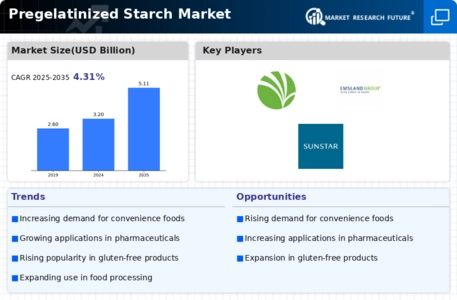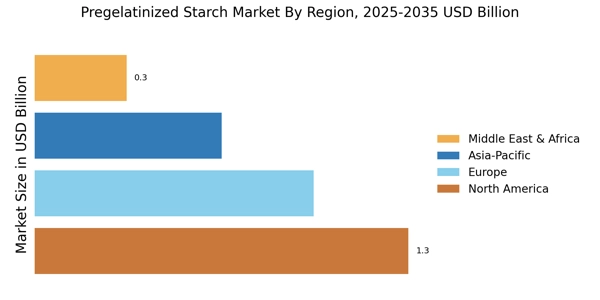Expansion in the Bakery Sector
The Pregelatinized Starch Market is significantly influenced by the expansion of the bakery sector. As consumer preferences shift towards convenience foods, the demand for pregelatinized starch in baked goods is on the rise. This starch enhances the texture and shelf life of products such as bread, cakes, and pastries. Recent market analysis suggests that the bakery segment is expected to grow at a rate of approximately 4.5% annually, driven by the increasing consumption of ready-to-eat and frozen bakery items. The ability of pregelatinized starch to improve moisture retention and prevent staling makes it a valuable ingredient in this sector. Consequently, the Pregelatinized Starch Market is likely to benefit from this trend, as manufacturers seek to meet the evolving demands of consumers for high-quality baked products.
Increasing Applications in Food Processing
The Pregelatinized Starch Market is experiencing a notable surge in demand due to its diverse applications in food processing. This starch is utilized as a thickening agent, stabilizer, and texturizer in various food products, including sauces, soups, and baked goods. The versatility of pregelatinized starch allows manufacturers to enhance the texture and mouthfeel of their products, which is increasingly important in a competitive market. According to recent data, the food processing sector accounts for a substantial portion of the overall demand for pregelatinized starch, with projections indicating a growth rate of approximately 5% annually. This trend suggests that as consumer preferences evolve towards convenience and quality, the Pregelatinized Starch Market will likely continue to expand, driven by innovation and the need for improved food formulations.
Growing Interest in Clean Label Ingredients
The Pregelatinized Starch Market is benefiting from the growing consumer interest in clean label ingredients. As consumers become more health-conscious, there is a marked shift towards products that contain natural and recognizable ingredients. Pregelatinized starch, often derived from natural sources, aligns well with this trend, making it an attractive option for food manufacturers. Market Research Future indicates that products labeled as clean label are experiencing a growth rate of approximately 7% annually. This shift suggests that the Pregelatinized Starch Market is likely to see increased adoption as manufacturers reformulate their products to meet consumer expectations for transparency and healthfulness. The emphasis on clean label products may drive innovation and further expand the market.
Rising Demand in Pharmaceutical Applications
The Pregelatinized Starch Market is also witnessing a significant increase in demand from the pharmaceutical sector. Pregelatinized starch serves as an excipient in tablet formulations, providing essential properties such as binding, disintegration, and controlled release. The pharmaceutical industry is projected to grow at a compound annual growth rate of around 6% over the next few years, which could further bolster the demand for pregelatinized starch. As the industry focuses on developing more efficient drug delivery systems, the role of pregelatinized starch becomes increasingly critical. This trend indicates that the Pregelatinized Starch Market is not only vital for food applications but is also becoming an integral component in pharmaceutical innovations, thereby diversifying its market potential.
Technological Advancements in Starch Production
Technological advancements in the production of pregelatinized starch are playing a pivotal role in shaping the Pregelatinized Starch Market. Innovations in processing techniques, such as extrusion and spray drying, have enhanced the efficiency and quality of starch production. These advancements not only improve the functional properties of pregelatinized starch but also reduce production costs, making it more accessible to various industries. As a result, the market is expected to witness a growth trajectory of around 5% over the next few years. The continuous improvement in production technologies indicates that the Pregelatinized Starch Market is poised for expansion, as manufacturers increasingly adopt these innovations to meet the rising demand for high-performance starches.


















Leave a Comment